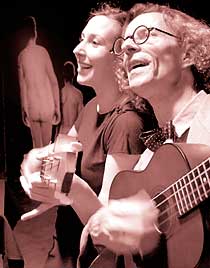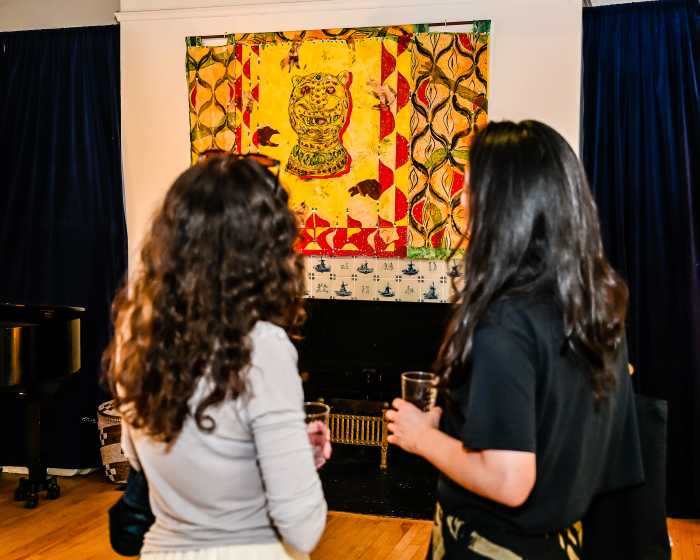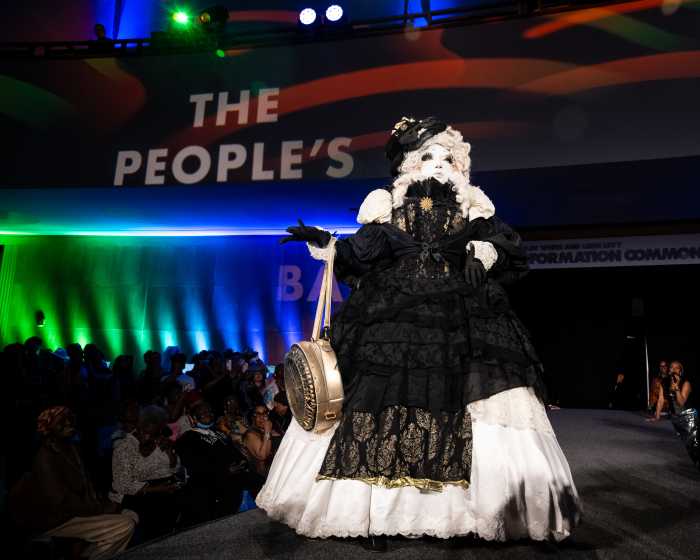Jim Strahs peers into the Magic Eight Ball
in his hand, waiting for the words to appear. After a moment,
he acknowledges the toy’s pseudo-prophetic powers by announcing,
"The answer is ’Yes,’ by the way."
But what was the question?
The image of a message bubbling up from the dark is an apt one
for encompassing Strahs and his dramaturgy. His is a theater
where "contemporary is the absolute" and a play’s seemingly
random collection of words mean exactly what they say, but what
they say has little meaning.
Seated next to collaborator Michael Stumm, Strahs seemed comfortable
being interviewed on the set of his show "How to Act,"
housed in the spare backroom of Chicago’s Lunar Cabaret last
month. On Aug. 11, Stumm and Strahs will bring their one-act
show to Combustive Arts, a 7-month-old theater in Williamsburg.
The set consists of several large photographic cutouts and a
seemingly random jumble of hand props: a fake mustache, a key,
a pistol and other theatrical flotsam. Like everything else about
the show, these items seemed both appropriate and incongruous
at the same time. It is a fine line to walk, but it’s one that
Strahs and Stumm have trod a long time.
With a professional association that stretches back to the Wooster
Group’s 1983 production of "North Atlantic," Strahs
and Stumm are in sync with each other’s performance aesthetic.
Their collaboration on "How to Act" is a good example.
For the most part, the play is an acting class that the audience
has paid to attend. Stumm plays Barry, an eccentric acting teacher
whose lengthy diatribe to his students includes pep talks, hygiene
advice, an overview of 2,000 years of theater history and an
odd assortment of ukulele tunes.
Marissa McKown, who plays the near-silent role of "stage
manager," is present on stage for the whole show and sings
backing vocals and plays second ukulele on several of the songs.
The melancholy songs were added by Stumm, who was given free
reign over the text by the playwright. The character in performance
is really an amalgam of its two creators: the words of Strahs
and the presence of Stumm.
"He’s certain facets of me and he’s certain facets of Jim,"
explained Stumm. "He’s very real. He’s a guy who is offering
us salvation. He simply, a) doesn’t know what it is, and b) needs
to pay the rent and c) he’s willing to work out his notion of
salvation in public."
Barry the moralist describes what to embrace as well as avoid
in the world, and his examples range from the anecdotal to shoving
his fingers up his nose and threatening to blow up his head.
The audience walks away from this bizarre and often amusing production
with a great deal of information and very little knowledge of
acting techniques.
For Stumm that is the point, or as much of a point as there can
be, to the show.
"What all acting classes should address is how do you act
like a human being," said Stumm. "How much does being
a human being have to do with what you are on stage? For most
actors, very f– little."
"Barry is using words to emphasize the body, and more often
than not in its most embarrassing form," said Strahs, sitting
next to one of the life-sized photos of naked men that serve
as the show’s backdrop. "If you are going to be concerned
with the body, it’s got to be the whole body Barry wants to say,
’Your ass–. Where is it?’"
Stumm, along with director Stefan Brun, picked up on the emphasis
on the corporal during rehearsals. He described his process as
one of "coding" and of creating a gestural language
to layer on the unencumbered words.
"My apprenticeship was served at the Wooster Group,"
said Stumm. "As a group, we didn’t care too terribly much
for stage directions. The notion being, that your own are always
more fun. Imagine the joy of getting a chunk of text that is
completely, let’s call it, attitude free."
The combination of words and gesture provides much of the humor
in "How to Act"; Barry’s grandiloquent speechifying
coupled with a finger wag or arm sweep. He is preening, and is
not let in on the joke. But Strahs insisted that he’s not a parody.
"Barry’s saying, ’Come on, people, get this. Go with me
here. I’m trying to teach you.’ And the laughter is a confirmation
that he’s not getting his point across."
The title of the show is misleading. "How to Act" teaches
little by way of Stanislavsky or Adler. But it does remain a
play about giving and receiving knowledge, albeit in a fractured
form. Stumm summed up the production by saying, "There’s
almost so much information it’s impossible to get to. Barry gets
to almost none of it."
Strahs added, "And that may be the absolute truth about
information."
"Information is completely useless," continued Stumm.
"Or it doesn’t exist. Information is possible to get to,
but think of what you have to wade through to get it – television,
street signage, the computer. It’s like "
"Tower of Babel," said Strahs, cutting him off. He
illustrated his point by picking up a round toy from the set.
"Strange plastic balls popping up. But they’re really contemporary.
Because that little piece, that little triangle of plastic is
really floating up in a different position every time. It’s doing
it now."
"How to Act" can be a hard play to pin down or even
categorize. Its own message jumps from the practical to the metaphysical,
from word to action. Is this a play that examines the craft of
acting? A performance piece that exemplifies a distrust of language?
An indoor tent show by a modern-day huckster?
Outlook Unclear. Try Again Later.
Combustive Motor Corporation and Wholesale/Chicago
present "How to Act" at Combustive Arts [250 Varet
St. between Bogart and White streets] at 8 pm on Aug. 11, Aug.
15-18, Aug. 21, Aug. 23, Aug. 28 and Aug. 30-Sept. 1. Tickets
are $10. For more information, call (718) 390-8825.






















